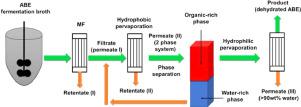Chemical Engineering and Processing: Process Intensification ( IF 4.3 ) Pub Date : 2021-05-13 , DOI: 10.1016/j.cep.2021.108462 Katarzyna Knozowska , Anna Kujawska , Guoqiang Li , Joanna Kujawa , Marek Bryjak , Wojciech Kujawski , Frank Lipnizki , Lilia Ahrné , Irena Petrinić , Jan K. Kujawski

|
Downstream processing of ABE fermentation broth is challenging issue. In this work, results of the application of both hydrophobic and hydrophilic commercial membranes during the pervaporation of ABE aqueous mixtures were investigated and presented. Hydrophobic pervaporation experiments were performed using ABE-water mixtures containing 0–5 wt% of organics in feed, using commercial membranes: POMS, PEBAX, and Pervap™4060. Separation factor and Pervaporation Separation Index were employed to discuss hydrophobic pervaporation results. Pervap™4060 membrane revealed the best separation performance in the removal of ABE components from diluted aqueous mixtures mimicking the fermentation broth, resulting in two-phase permeate containing ca. 34 wt% of organics. The subsequent liquid-liquid phase separation resulted in the organic phase containing 62 wt% of ABE. Hydrophilic pervaporation experiments were performed in contact with ABE-water system initially comprising 38 wt% of water applying both the Pervap™4100 PVA based polymeric membrane and modified silica ceramic one. Application of hydrophilic membranes allowed for the complete dewatering of ABE-water mixtures. Eventually, the combination of membrane separation processes (microfiltration, hydrophobic pervaporation, hydrophobic thermopervaporation, membrane distillation, and hydrophilic pervaporation) enhanced by the liquid-liquid phase separation was suggested for the recovery and dehydration of ABE aqueous mixture.
中文翻译:

膜辅助处理丙酮,丁醇和乙醇(ABE)的水流
ABE发酵液的下游加工是一个具有挑战性的问题。在这项工作中,研究和介绍了疏水性和亲水性商用膜在ABE水性混合物全蒸发过程中的应用结果。疏水渗透蒸发实验是使用ABE-进料中含有0-5 wt%有机物的水混合物,使用商业膜:POMS,PEBAX和Pervap™4060进行的。利用分离因子和渗透蒸发分离指数讨论了疏水渗透蒸发的结果。Pervap™4060膜在从模仿发酵液的稀释水性混合物中去除ABE组分方面显示出最佳的分离性能,从而产生了约含2%的两相渗透物。34重量%的有机物。随后的液-液相分离导致有机相包含62重量%的ABE。亲水性全蒸发实验是与ABE-水系统接触进行的,该系统最初包含38%(重量)的水,同时使用Pervap™4100 PVA基聚合物膜和改性二氧化硅陶瓷膜。亲水膜的应用使ABE-水混合物完全脱水。最终,提出了通过液-液相分离来增强膜分离工艺(微滤,疏水性全蒸发,疏水性热全蒸发,膜蒸馏和亲水性全蒸发)的组合,以回收和脱水ABE水性混合物。亲水性全蒸发实验是与ABE-水系统接触进行的,该系统最初包含38%(重量)的水,同时使用Pervap™4100 PVA基聚合物膜和改性二氧化硅陶瓷膜。亲水膜的应用使ABE-水混合物完全脱水。最终,提出了通过液-液相分离来增强膜分离过程(微滤,疏水性全蒸发,疏水性热全蒸发,膜蒸馏和亲水性全蒸发)的组合,以回收和脱水ABE水性混合物。亲水性全蒸发实验是与ABE-水系统接触进行的,该系统最初包含38%(重量)的水,同时使用Pervap™4100 PVA基聚合物膜和改性二氧化硅陶瓷膜。亲水膜的应用使ABE-水混合物完全脱水。最终,提出了通过液-液相分离来增强膜分离过程(微滤,疏水性全蒸发,疏水性热全蒸发,膜蒸馏和亲水性全蒸发)的组合,以回收和脱水ABE水性混合物。



























 京公网安备 11010802027423号
京公网安备 11010802027423号